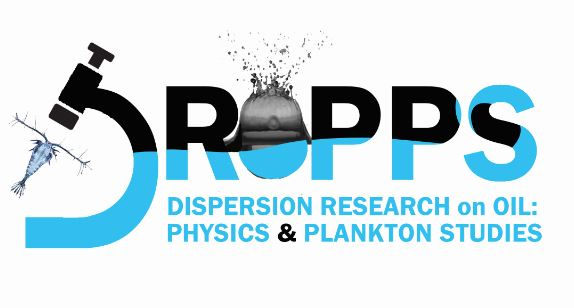Scientists generated breaking waves in the presence of various dispersant and oil ratios (DOR) using a custom-built wave tank to investigate how subsurface oil droplets evolve in a turbulent environment. The experiments showed that initially (first 10 seconds after breaking waves), turbulence and buoyant rise played the most significant role in dispersion. There was very little droplet fragmentation after initial breakup, except at high dispersant concentration DOR 1:25, and to a lesser extent DOR 1:100. The concentration of microscale droplets at these DORs continued increasing for 10 minutes due to microthreads (associated with tip streaming) fragmenting, which subsequently broke into micron-scale droplets. Between 10 minutes and 2 hours, the concentration of tiny droplets (<10 μm) decreased only slightly, but larger diameter droplets decreased about 2 times. These results suggest that for higher DOR, tip streaming may play a more significant role than turbulence and buoyant rise in the breakup process.
The researchers published their findings in the Journal of Geophysical Research: Oceans: Size distribution and dispersion of droplets generated by impingement of breaking waves on oil slicks.
A marine oil slick changes as it interacts with its physical, chemical, and biological environment. Waves are the primary energy source for breaking oil slicks into droplets and entraining them into the water column. Chemical dispersant application is used to enhance these processes by further reducing droplet sizes generated by breaking waves. This recent study sought to better understand dispersant’s effect on droplet size distribution after initial breakup and contribute to the bigger picture that connects small-scale physical ocean processes that breakup an oil slick and large-scale oceanic transport.
Earlier studies investigating droplet size distributions employed two methods: 1) numerical simulation using input from mixing container experiments (did not result in a unified theory to predict droplet size distribution generated by waves); and 2) collecting oil samples at different ocean depths and times after wave breaking and observing them microscopically (which resulted in datasets used for developing a semi-empirical droplet size distribution model).
This study’s research team systematically made in situ measurements of evolving droplet size distribution generated by 2-D breaking waves in a laboratory wave tank. The team used mixtures of Corexit 9500A and Macondo 252 surrogate oil (and other oils for viscosity effects) at dispersant-oil ratios 1:25, 1:100, 1:500, and 0. They visualized the dispersion processes using three high-resolution (2016×2016 pixels), high-speed (500 frames per second) cameras. Using two-dimensional Particle Image Velocimetry and Holography (a 3-D imaging technique), they characterized turbulence after wave breaking and quantified the subsurface droplet size distribution. The measurements covered the initial rapid entrainment and fragmentation phase (when the oil formed distinct clouds) and extended to the slower phase (when turbulent diffusion and buoyant rise dominated droplet transport).
The experiments showed that turbulent waves plunge down and splash up multiple times leaving a series of droplet and bubble clouds behind. The wave structures and subsurface clouds for oil-only and dispersant-oil treatments had similar features; however, the droplet sizes were strikingly different. The DOR 1:25 treatments formed an opaque cloud with droplets sizes that fell below the resolution range of the high-speed imaging system. The concentration of micron-sized droplets increased for the first 10 minutes after entrainment, which a previous study attributed to tip streaming (microthreads that detach from larger oil masses).
The authors noted that an unresolved issue is the size distributions of oil-dispersant mixtures below the 2 μm range and into the nanoscale, which they hope future studies will address. Viewing water samples from the DOR 1:25 treatments, they observed numerous 1 μm and smaller droplets that had not been quantified. A cloud of these small droplets remained suspended in the water, consistent with phenomena observed in submerged plumes (see Study Assesses How Chemical Dispersant Affects Oil Plume Behavior).
By Nilde Maggie Dannreuther.



